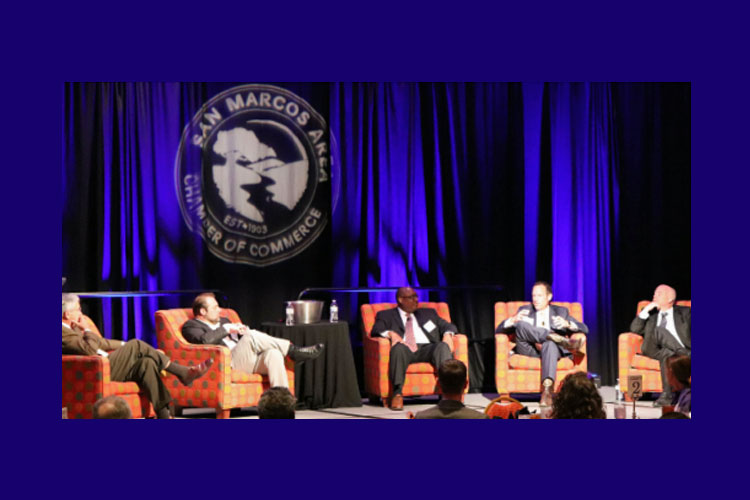
San Marcos Chamber of Commerce Hosts 2017 Transportation Summit
I want them to use private companies and private contractors to find those solutions. Because I would rather us grow our businesses in the state of Texas…instead of growing our government.”
By Terra Rivers, Managing Editor
On Thursday, Oct. 26, the San Marcos Area Chamber of Commerce Hosted the 2017 Transportation Summit.
A panel of experts gathered at the San Marcos Convention Center at Embassy Suites to discuss transportation issues the Central Texas Corridor between Austin and San Antonio is currently facing.
The panelists included Will Conley, CAMPO Chair, Ashby Johnson, Executive Director of CAMPO, State Rep. Jason Isaac, R-Dripping Springs, and Kevin Wolff, Bexar County Commissioner. The panel’s moderator was Mike Heiligenstein, Executive Director Central Texas Regional Mobility Authority.
“Around the year 2000 in our state, two things really occurred,” Conley said. “One, our federal highway funds had become insolvent and remain insolvent today. Two, our traditional state highway funds basically had the ability, at that time, to maintain the system that we had on the ground and to do very little improvements in what we call mobility dollars.”
Commissioner Wolff said in San Antonio’s 25-year plan, they have a list of must have projects worth $17 billion.
“As we all know and hear, the fastest growing corridor in the entire United States runs through Bexar County up to Williamson County,” Wolf said. “And you feel that so much in Hays because you guys are right there in the middle of that corridor.”
Rep. Isaac said 25 percent of the Oil and Gas tax goes to public education; previously, the other 75 percent went into the state’s rainy day fund. However, legislation in recent years have cut that number, so that 37.5 percent goes into the rainy-day fund and the remaining 37.5 percent goes directly into the road improvements.
“TxDOT is having some issues because I feel like they’ve got more money than they know what to do with,” Isaac said, “That they could spend effectively. They’re wanting to hire thousands of people, and I don’t want them to hire thousands of people. I want them to use private companies and private contractors to find those solutions. Because I would rather us grow our businesses in the state of Texas…instead of growing our government.”
The panelists discussed transportation issues throughout the Austin-San Antonio I-35 corridor, and the projects, which were underway because of local and state partnerships.
Included in the panel discussion was the use of technology, including smart technology, IoT (Internet of Things) and the use of innovative ideas to expand and improve transportation of freight.
Rep. Isaac told the story of a third-grader, who in 2014 wrote to him about an accident she’d witnessed on FM 1826.
Isaac said the girl told him the story of how she had been on her way to practice when she witnessed an accident on FM 1826; ever since, she had been afraid to travel on that road. Isaac said the road was on a list of TxDOT’s projects but was placed at the very bottom and unlikely to be funded.
“So, I sent her on this lobbying effort as a third-grader to go out and get some letters of support from other neighbors and other students in her class. And I was surprised when I did a skype call with her class how many of the 20 students lived on that same road. Almost two-thirds of the students lived along that road and traveled on that road. Well, she got resolutions from the school district to the support of funding for improvements on that road…” as well as the city and other neighborhoods and organizations.
“Her challenge was to get 60 letters,” Isaac said. “Well, she got 180 including the resolutions…and presented this envelope with all these resolutions and letters to TxDOT. About two days later, they approved the funding for this project. So, it was a big win. This 3rd grade girl recognized…recognized she was my boss, and so she contacted me, and the process began.”
Isaac said despite the new projects approval, later that year, TxDOT crews were installing guardrails and concrete barriers along the road, which would be removed the following years when the expansion project began.
“There is no coordination between these existing projects and projects that may already be approved. And we wasted hundreds of thousands of our dollars [putting in these guard rails and barriers]. You should be as furious as I was and have as many meetings with TxDOT as I did about the waste of our dollars.”
Throughout the discussion, the panelists talked about the collective effort between state and local officials as well as the communities to improve roads and transportation throughout the Corridor.
“As I was coming in from Wimberley today, I was reminded about of how proactive this community has been and how active our local leadership has been. As a representative of the state, we have been in an over 10-year formal agreement with the Department of Transportation; we’ve built over a half million dollars’ worth of state high way improvements alone,” said Conley.






